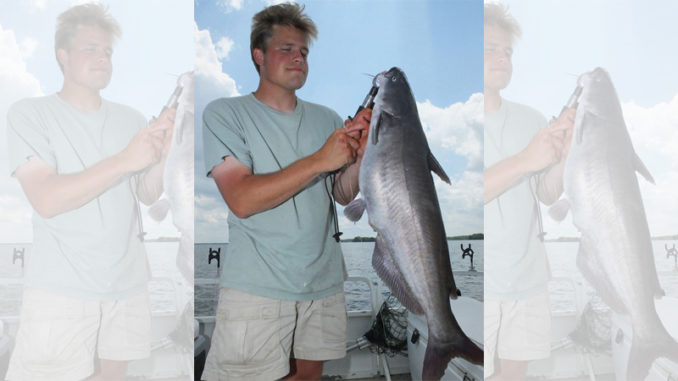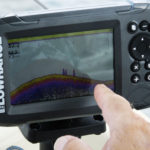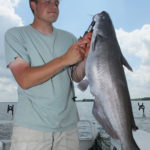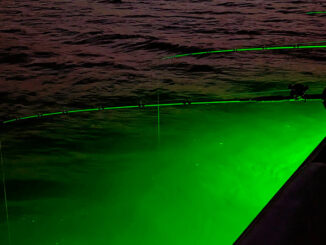
Don’t give up on catfish when August arrives
Bobby Winters is a 23-year-old catfish and striper guide on the Santee Cooper lakes who has a youthful passion for catching fish. We were fishing on a hot, summer day, and he’d targeted an area with undulating bottom contours for drift-fishing. We had been drifting only a short while when one of his nine rods bowed over.
Winters grabbed the 8-foot Eagle Claw rod, and immediately, the adjacent rod buried in a deep arch. In true gunslinger mode, Winters snatched it from the rod holder with his left hand, only to see four more rods bow over in succession.
He gave me and his dad, long-time guide Bob Winters, the “Okay, I need help” look, and we gladly obliged. Of the six catfish hooked, we boated five. The sixth broke the line before we could get to it.
This wild action took place near mid-day in the heat of summer in shallow water on Lake Moultrie. Bobby Winters said that scenario was not a fluke occurrence. It’s a solid catfishing pattern.
Many anglers get into a deep water mindset during the summer, and that can be a very productive choice. But often, the relativity shallow water consistently produces excellent daytime fishing on both Moultrie and Lake Marion.
“A lot of fishermen are surprised that catfish — big catfish and plenty of fish in the 10-pound-plus class — are available in water from 8 to 15 feet deep,” he said. “As in any fishing, it can vary with weather and forage movements. But it’s very consistent throughout the summer, including August.”
Finding bait is the key
Winters (843-700-0626) said the fishing is often an extension of areas where he fishes even shallower during the spring and fall. But the area needs to have ample forage to hold catfish.
“The areas where I have the most success have a series of underwater hills and valleys,” he said. “This up-and-down change in bottom topography is important. That’s because it gives catfish different depths to relate to during the day. I look for areas that may be 15 feet or more at the deepest point that rise to less than 10 feet, then drop back deep.
“If I’m drifting toward the shoreline from the open water, the up-down undulations will eventually get shallower. But the fish are often surprisingly shallow. I’ll work into shallow water until I get a pattern for the day, then focus on it until the pattern changes.”
On our trip, catfish were clustered in specific areas, but the precise location changed from one drift to the next. Even in the mid-day sun, we hooked three catfish at one time on one drift. And we had several other doubles in addition to the initial six-pack. The fish were clustered in groups, and multiple hookups were common. But it’s not always like that.
Winters said on other days, the action is consistent, but without the multiple hookups. It changes daily, but the end result is usually plenty
On that trip, we didn’t land any monster-sized catfish, but the odds of hooking fish in the 20- to 30-pound class are reasonable. The Winters have boated numerous fish weighing more than 40 pounds. And on occasional trips, they’ve landed multiple big fish. This is an excellent tactic for big fish as well as numbers.
Stick with a pattern that’s working, and change when it slows down
“Patience is a key, and understanding that something on the lake bottom will attract and hold them in a specific area for a while,” he said. “It may be forage or other bottom features, but they’ll congregate in specific places.
“I’ve learned that drifting in the deeper water and up a slope to the top of the hump seems to produce more bites than working down the hill,” he said. “But we fish it all, and when I begin to get a daily pattern, I’ll focus on those specific type areas until that action slows.”
Winters said he uses the typical Santee drift rig, and he prefers to drift at a rate of 0.5 to 0.7 miles per hour. Bait choice is important. Gizzard shad, herring and natural forage, including white perch and bream, are all very effective.
“The occasional windy days during the summer seem to be best for the larger fish. An overcast, windy day is ideal for big catfish and numbers of fish,” he said. “But big-fish bites can happen anytime, even midday during hot weather.”
Winters said like every type of fishing, conditions can change, and a deep-water bite may be best for short periods of time. If the shallow bite is slow, Winters will readily go deep. But shallow-water drift-fishing is his go-to tactic through the summer, and it typically produces plenty of catfish action.
Click here for tips on catching Santee’s summertime shellcrackers.






